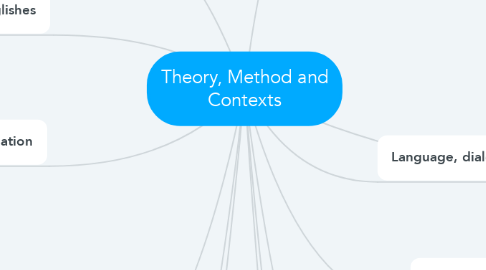
1. Accent
1.1. The pronunciation of sounds, to stress and intonation, or to the rhythm of speech.
1.2. Accent also leads to controversies about which one is superior, desirable, and so on.
2. Varieties of world Englishes
2.1. The varieties of English that are commonly accepted and are considered ‘legitimate’ for educational purposes all over the world are American and British English.
2.2. The other varieties, Australian, Canadian and New Zealand English, are still trying to achieve legitimacy
3. Diffusion and Variation
3.1. The fact that there already is a great deal of variation in what is known as English, as has already been pointed out; there are regional variations in, e.g., American and British Englishes, and there are variations related to age, gender, etc.
4. External models in the Outer and Expanding Circles
4.1. Ideogical
4.1.1. Marckwardt (1942: 309) wrote that ‘the acceptance as a standard of one type of speech over another is based not upon linguistic considerations but rather upon political, cultural, and economic factors’.
4.2. the basis of arguments
4.2.1. 1. A uniform standard world-wide is essential for maintaining ‘world English’ or ‘international English’ or ‘global English’ as a viable means of communication (a lingua franca).
4.2.2. 2. There are already varieties that have been codified after extensive and intensive research.
4.2.3. 3. The relationship between language and culture is organic, and all this talk of nativization and acculturation does not change the fact that English necessarily reflects British and/or American culture.
4.2.4. 4. the case in favor of regional norms, such as South Asian, African, South-East Asian, etc., reflects ‘liberation linguistics’ ideologies and is motivated by considerations of power.
5. Ideological perspectives
5.1. Phillipson and Pennycook represent views of English and of English teaching and learning which have raised important questions that contribute to the entire debate on the benefits and drawbacks of the spread of English.
6. Multilingual English users
6.1. Multilingual language users have more options of codes, strategies, and nuances since they control more than one linguistic system.
6.2. Multilingual people’s grammars are best thought of in terms of ‘verbal repertoires’; they use ‘a formally and functionally determined range of languages
7. Individuals do not speak a ‘language’, they speak a ‘variety’ of a language, or a ‘dialect’. We identify the national varieties by terms such as American English, Australian English and British English. Within each nation, we identify varieties by regions.
8. The world-wide diffusion of English
8.1. Two diasporas of the spread of English
8.1.1. As a consequence of the migration of English-speaking people from Great Britain to Australia, North America, and New Zealand.
8.1.2. Resulted primarily from the diffusion of English among speakers of diverse groups of peoples and languages across the world as a result of colonialism and other political and economic factors.
8.2. The English-using world in terms of three concentric circles
8.2.1. The Inner Circle comprises the ‘mother country' (England and the British Isles) and the areas where the speakers from Britain took the language with them as they migrated (Australia, New Zealand and North America).
8.2.2. The Outer Circle comprises the countries where the language was transplanted by a few colonial administrators, businessmen, educators, and missionaries, and is now nurtured by the vast majority of indigenous multilingual users.
8.2.3. The Expanding Circle represents the countries (e.g., People’s Republic of China, Japan, Korea, Thailand, countries of Europe, the Middle East, and Latin America) where the language is still spreading, mainly for serving the need for an international medium in business and commerce, diplomacy, finance, and other such spheres.
